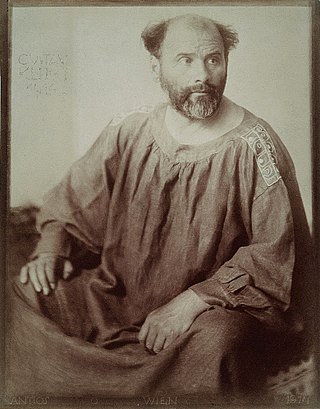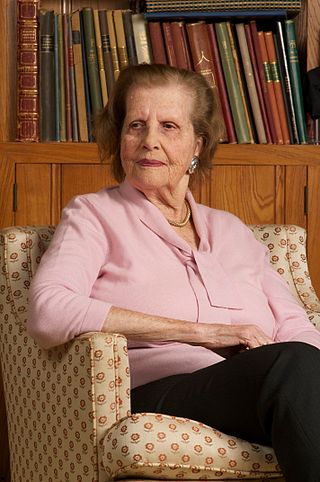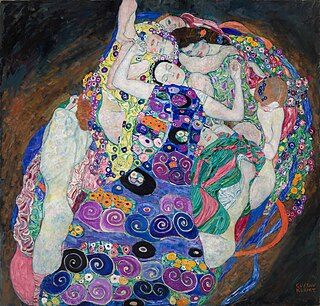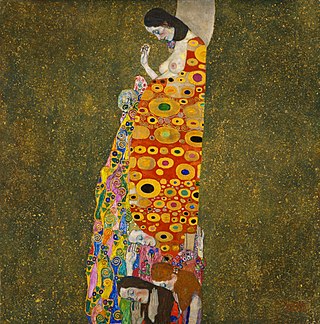
Gustav Klimt was an Austrian symbolist painter and one of the most prominent members of the Vienna Secession movement. Klimt is noted for his paintings, murals, sketches, and other objets d'art. Klimt's primary subject was the female body, and his works are marked by a frank eroticism. Amongst his figurative works, which include allegories and portraits, he painted landscapes. Among the artists of the Vienna Secession, Klimt was the most influenced by Japanese art and its methods.

The Neue Galerie New York is a museum of early twentieth-century German and Austrian art and design located in the William Starr Miller House at 86th Street and Fifth Avenue in New York City. Established in 2001, it is one of the most recent additions to New York City's famed Museum Mile, which runs from 83rd to 105th streets on Fifth Avenue in the Upper East Side of Manhattan.

The Vienna Secession is an art movement, closely related to Art Nouveau, that was formed in 1897 by a group of Austrian painters, graphic artists, sculptors and architects, including Josef Hoffman, Koloman Moser, Otto Wagner and Gustav Klimt. They resigned from the Association of Austrian Artists in protest against its support for more traditional artistic styles. Their most influential architectural work was the Secession exhibitions hall designed by Joseph Maria Olbrich as a venue for expositions of the group. Their official magazine was called Ver Sacrum, which published highly stylised and influential works of graphic art. In 1905 the group itself split, when some of the most prominent members, including Klimt, Wagner, and Hoffmann, resigned in a dispute over priorities, but it continued to function, and still functions today, from its headquarters in the Secession Building. In its current form, the Secession exhibition gallery is independently led and managed by artists.

The Österreichische Galerie Belvedere is a museum housed in the Belvedere palace, in Vienna, Austria.

Maria Altmann was an Austrian-American Jewish refugee from Austria, who fled her home country after it was annexed to the Nazi’s Third Reich. She is noted for her ultimately successful legal campaign to reclaim from the Government of Austria five family-owned paintings by the artist Gustav Klimt that were stolen by the Nazis during World War II.

The Kiss is an oil-on-canvas painting with added gold leaf, silver and platinum by the Austrian Symbolist painter Gustav Klimt. It was painted at some point in 1907 and 1908, during the height of what scholars call his "Golden Period". It was exhibited in 1908 under the title Liebespaar as stated in the catalogue of the exhibition. The painting depicts a couple embracing each other, their bodies entwined in elaborate robes decorated in a style influenced by the contemporary Art Nouveau style and the organic forms of the earlier Arts and Crafts movement.

Portrait of Adele Bloch-Bauer I is an oil painting on canvas, with gold leaf, by Gustav Klimt, completed between 1903 and 1907. The portrait was commissioned by the sitter's husband, Ferdinand Bloch-Bauer, a Viennese and Jewish banker and sugar producer. The painting was stolen by the Nazis in 1941 and displayed at the Österreichische Galerie Belvedere. The portrait is the final and most fully representative work of Klimt's golden phase. It was the first of two depictions of Adele by Klimt—the second was completed in 1912; these were two of several works by the artist that the family owned.

The Klimt University of Vienna Ceiling Paintings, also known as the Faculty Paintings, were a series of paintings made by Gustav Klimt for the ceiling of the University of Vienna's Great Hall between the years of 1900–1907. In 1894, Klimt was commissioned to paint the ceiling. Upon presenting his paintings, Philosophy, Medicine and Jurisprudence, Klimt came under attack for 'pornography' and 'perverted excess' in the paintings. None of the paintings would go on display in the university.

The Beethoven Frieze is a painting by Gustav Klimt on display in the Secession Building, Vienna, Austria.

Emilie Louise Flöge was an Austrian fashion designer and businesswoman. She was the life companion of the painter Gustav Klimt.

The Stoclet Frieze is a series of three mosaics created by the Austrian painter Gustav Klimt for a 1905-1911 commission for the Stoclet Palace in Brussels, Belgium. The panels depict swirling Tree of life, a standing female figure and an embracing couple.

Judith and the Head of Holofernes is an oil painting by Gustav Klimt, painted in 1901. It depicts the biblical figure Judith holding the head of Holofernes after beheading him. The beheading and its aftermath have been commonly portrayed in art since the Renaissance, and Klimt himself would paint a second work depicting the subject in 1909.

The Tree of Life, Stoclet Frieze is a painting by the Austrian symbolist painter Gustav Klimt. It was completed in 1909 and is based on the Art Nouveau (Modern) style in a symbolic painting genre. The dimensions of the painting are 195 by 102 centimetres, and it is housed at the Museum of Applied Arts, Vienna, Austria.

Death and Life is an oil-on-canvas painting by Austrian painter Gustav Klimt. The painting was started in 1908 and completed in 1915. It depicts an allegorical subject in an Art Nouveau (Modern) style. The painting measures 178 by 198 centimeters and is now housed at the Leopold Museum in Vienna.

Serena (Szeréna) Pulitzer Lederer was an Austro-Hungarian art collector and the spouse of the industrial magnate August Lederer, close friend of Gustav Klimt and instrumental in the constitution of the collection of Klimt's art pieces.
Hope I is an oil painting created by Gustav Klimt in 1903. It is 189 cm x 67 cm and currently located in the National Gallery of Canada, Ottawa. The main subject of this work is a pregnant, nude female. She is holding her hands together above her stomach and close to her chest. She gazes directly at the viewer and has a great mass of hair with a crown of forget-me-not flowers placed on her head. The scene is beautiful upon first glance but once the viewer's eyes move to the background, deathlike figures become noticeably present.

The Maiden is a painting by the Austrian painter Gustav Klimt painted in 1913. The Maiden was one of Klimt's last paintings before he died. Currently it is stored in the National Gallery in Prague, Czech Republic.

Hope II is an oil-on-canvas painting with added gold and platinum by the Austrian symbolist artist Gustav Klimt, made in 1907–08, depicting a pregnant woman with closed eyes. It was the second of Klimt's works to focus on a pregnant woman, both depicting Herma, one of his favourite models. It was entitled Vision by Klimt, but has become known as Hope II after the earlier work Hope, which is now distinguished as Hope I. Hope II was acquired by the Museum of Modern Art in New York City in 1978.

Insel im Attersee is a 1901-1902 landscape painting by the Austrian artist Gustav Klimt (1862-1918).

















